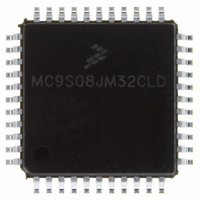MC9S08JM32CLD Freescale Semiconductor, MC9S08JM32CLD Datasheet - Page 66

MC9S08JM32CLD
Manufacturer Part Number
MC9S08JM32CLD
Description
IC MCU 8BIT 32K FLASH 44-LQFP
Manufacturer
Freescale Semiconductor
Series
HCS08r
Datasheet
1.MC9S08JM32CLD.pdf
(388 pages)
Specifications of MC9S08JM32CLD
Core Processor
HCS08
Core Size
8-Bit
Speed
48MHz
Connectivity
I²C, LIN, SCI, SPI, USB
Peripherals
LVD, POR, PWM, WDT
Number Of I /o
33
Program Memory Size
32KB (32K x 8)
Program Memory Type
FLASH
Ram Size
2K x 8
Voltage - Supply (vcc/vdd)
2.7 V ~ 5.5 V
Data Converters
A/D 8x12b
Oscillator Type
External
Operating Temperature
-40°C ~ 85°C
Package / Case
44-LQFP
Processor Series
S08JM
Core
HCS08
Data Bus Width
8 bit
Data Ram Size
2 KB
Interface Type
SCI/SPI
Maximum Clock Frequency
24 MHz
Number Of Programmable I/os
33
Number Of Timers
8
Maximum Operating Temperature
+ 85 C
Mounting Style
SMD/SMT
3rd Party Development Tools
EWS08
Development Tools By Supplier
DEMOJM, DEMOJMSKT, DEMOFLEXISJMSD, DEMO9S08JM16
Minimum Operating Temperature
- 40 C
On-chip Adc
8-ch x 12-bit
Lead Free Status / RoHS Status
Lead free / RoHS Compliant
Eeprom Size
-
Lead Free Status / Rohs Status
Lead free / RoHS Compliant
Available stocks
Company
Part Number
Manufacturer
Quantity
Price
Company:
Part Number:
MC9S08JM32CLD
Manufacturer:
Freescale Semiconductor
Quantity:
1 948
Company:
Part Number:
MC9S08JM32CLD
Manufacturer:
Freescale Semiconductor
Quantity:
10 000
- Current page: 66 of 388
- Download datasheet (5Mb)
Chapter 5 Resets, Interrupts, and System Configuration
Each of these sources, with the exception of the background debug forced reset, has an associated bit in
the system reset status (SRS) register.
5.4
Computer Operating Properly (COP) Watchdog
The COP watchdog is intended to force a system reset when the application software fails to execute as
expected. To prevent a system reset from the COP timer (when it is enabled), application software must
reset the COP counter periodically. If the application program gets lost and fails to reset the COP counter
before it times out, a system reset is generated to force the system back to a known starting point.
After any reset, the COP watchdog is enabled (see
Section 5.7.4, “System Options Register 1
(SOPT1),”
for additional information). If the COP watchdog is not used in an application, it can be disabled by
clearing COPT bits in SOPT1.
The COP counter is reset by writing 0x55 and 0xAA (in this order) to the address of SRS during the
selected timeout period. Writes do not affect the data in the read-only SRS. As soon as the write sequence
is done, the COP timeout period is restarted. If the program fails to do this during the time-out period, the
MCU will reset. Also, if any value other than 0x55 or 0xAA is written to SRS, the MCU is immediately
reset.
The COPCLKS bit in SOPT2 (see
Section 5.7.5, “System Options Register 2
(SOPT2),” for additional
information) selects the clock source used for the COP timer. The clock source options are either the bus
clock or an internal 1 kHz LPO clock source. With each clock source, there are three associated time-outs
controlled by the COPT bits in SOPT1.
Table 5-6
summaries the control functions of the COPCLKS and
COPT bits. The COP watchdog defaults to operation from the 1 kHz LPO clock source and the longest
10
time-out (2
cycles).
When the bus clock source is selected, windowed COP operation is available by setting COPW in the
SOPT2 register. In this mode, writes to the SRS register to clear the COP timer must occur in the last 25%
of the selected timeout period. A premature write immediately resets the MCU. When the 1 kHz LPO clock
source is selected, windowed COP operation is not available.
The COP counter is initialized by the first writes to the SOPT1 and SOPT2 registers and after any system
reset. Subsequent writes to SOPT1 and SOPT2 have no effect on COP operation. Even if the application
will use the reset default settings of COPT, COPCLKS, and COPW bits, the user must write to the
write-once SOPT1 and SOPT2 registers during reset initialization to lock in the settings. This will prevent
accidental changes if the application program gets lost.
The write to SRS that services (clears) the COP counter must not be placed in an interrupt service routine
(ISR) because the ISR could continue to be executed periodically even if the main application program
fails.
If the bus clock source is selected, the COP counter does not increment while the MCU is in background
debug mode or while the system is in stop mode. The COP counter resumes when the MCU exits
background debug mode or stop mode.
If the 1 kHz LPO clock source is selected, the COP counter is re-initialized to zero upon entry to either
background debug mode or stop mode and begins from zero upon exit from background debug mode or
stop mode.
MC9S08JM60 Series Data Sheet, Rev. 3
66
Freescale Semiconductor
Related parts for MC9S08JM32CLD
Image
Part Number
Description
Manufacturer
Datasheet
Request
R
Part Number:
Description:
Manufacturer:
Freescale Semiconductor, Inc
Datasheet:
Part Number:
Description:
Manufacturer:
Freescale Semiconductor, Inc
Datasheet:
Part Number:
Description:
Manufacturer:
Freescale Semiconductor, Inc
Datasheet:
Part Number:
Description:
Manufacturer:
Freescale Semiconductor, Inc
Datasheet:
Part Number:
Description:
Manufacturer:
Freescale Semiconductor, Inc
Datasheet:
Part Number:
Description:
Manufacturer:
Freescale Semiconductor, Inc
Datasheet:
Part Number:
Description:
Manufacturer:
Freescale Semiconductor, Inc
Datasheet:
Part Number:
Description:
Manufacturer:
Freescale Semiconductor, Inc
Datasheet:
Part Number:
Description:
Manufacturer:
Freescale Semiconductor, Inc
Datasheet:
Part Number:
Description:
Manufacturer:
Freescale Semiconductor, Inc
Datasheet:
Part Number:
Description:
Manufacturer:
Freescale Semiconductor, Inc
Datasheet:
Part Number:
Description:
Manufacturer:
Freescale Semiconductor, Inc
Datasheet:
Part Number:
Description:
Manufacturer:
Freescale Semiconductor, Inc
Datasheet:
Part Number:
Description:
Manufacturer:
Freescale Semiconductor, Inc
Datasheet:
Part Number:
Description:
Manufacturer:
Freescale Semiconductor, Inc
Datasheet:











